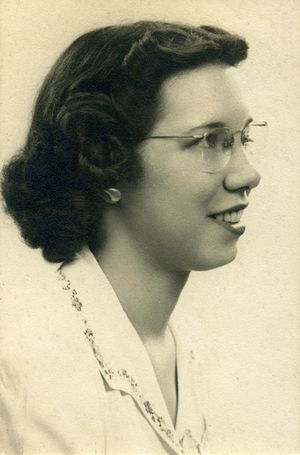Betty Holberton: Difference between revisions
m (Text replace - "[[Category:Computers_and_information_processing" to "[[Category:Computing and electronics") |
No edit summary |
||
| (2 intermediate revisions by the same user not shown) | |||
| Line 1: | Line 1: | ||
== Biography == | == Biography == | ||
Betty Holberton was born in 1917 in Philadelphia as Frances Elizabeth | [[Image:Betty-1944-loeb.jpg|thumb|right|Betty Snyder, 1944. Photo courtesy Priscilla Holberton]] | ||
Betty Holberton was born in 1917 in Philadelphia as Frances Elizabeth Snyder. She attended the University of Pennsylvania during the 1940s and studied journalism which allowed her to travel a lot. During the Second World War, when men were fighting in the war, the US army was hiring women to calculate ballistic trajectories. Betty Snyder was chosen by the Moore School of Engineering and soon by the [[ENIAC]] along with [[Ruth Teitelbaum]], [[Marlyn Meltzer]] and others as a ‘computer’. The Moore School at UPenn was funded by the US Army during the Second World War. Here a group of about 80 women worked manually calculating ballistic trajectories - complex differential calculations. These women were called ‘computers’. In 1945, the Army decided to fund an experimental project – the first all-electronic digital computer and six of the women ‘computers’ were selected to be its first programmers. Among these six was Betty Holberton. | |||
The ENIAC was the first all-electronic digital computer, a huge machine of forty black 8-foot panels. The programmers had none of the programming tools of today and it was a challenge to make the ENIAC work. The six programmers had to physically conduct the ballistic program using 3000 switches and dozens of switches and digital trays to route the data and program pulses through the machine. They used analog technology to calculate ballistic trajectory equations. Initially the ENIAC was classified. In 1946, the ENIAC computer was unveiled before the public and the press. The six women were the only generation of programmers to program the ENIAC. | The ENIAC was the first all-electronic digital computer, a huge machine of forty black 8-foot panels. The programmers had none of the programming tools of today and it was a challenge to make the ENIAC work. The six programmers had to physically conduct the ballistic program using 3000 switches and dozens of switches and digital trays to route the data and program pulses through the machine. They used analog technology to calculate ballistic trajectory equations. Initially the ENIAC was classified. In 1946, the ENIAC computer was unveiled before the public and the press. The six women were the only generation of programmers to program the ENIAC. | ||
| Line 11: | Line 13: | ||
{{DEFAULTSORT:Holberton}} | {{DEFAULTSORT:Holberton}} | ||
[[Category: | [[Category:Computing_and_electronics]] | ||
[[Category:Computer_architecture]] | [[Category:Computer_architecture]] | ||
[[Category:Computer_classes]] | [[Category:Computer_classes]] | ||
[[Category:Computer_science]] | [[Category:Computer_science]] | ||
[[Category:Computing]] | [[Category:Computing]] | ||
Revision as of 17:56, 13 October 2014
Biography
Betty Holberton was born in 1917 in Philadelphia as Frances Elizabeth Snyder. She attended the University of Pennsylvania during the 1940s and studied journalism which allowed her to travel a lot. During the Second World War, when men were fighting in the war, the US army was hiring women to calculate ballistic trajectories. Betty Snyder was chosen by the Moore School of Engineering and soon by the ENIAC along with Ruth Teitelbaum, Marlyn Meltzer and others as a ‘computer’. The Moore School at UPenn was funded by the US Army during the Second World War. Here a group of about 80 women worked manually calculating ballistic trajectories - complex differential calculations. These women were called ‘computers’. In 1945, the Army decided to fund an experimental project – the first all-electronic digital computer and six of the women ‘computers’ were selected to be its first programmers. Among these six was Betty Holberton.
The ENIAC was the first all-electronic digital computer, a huge machine of forty black 8-foot panels. The programmers had none of the programming tools of today and it was a challenge to make the ENIAC work. The six programmers had to physically conduct the ballistic program using 3000 switches and dozens of switches and digital trays to route the data and program pulses through the machine. They used analog technology to calculate ballistic trajectory equations. Initially the ENIAC was classified. In 1946, the ENIAC computer was unveiled before the public and the press. The six women were the only generation of programmers to program the ENIAC.
After the war, Holberton worked at Remington Rand, a business machines manufacturer and then at the National Bureau of Standards, a measurement standards laboratory. Here she worked on the first two revisions of the FORTRAN language standard – FORTRAN77 and FORTRAN90. In 1959, she was the Chief of the Programming Research Branch, Applied Mathematics Laboratory at the David Taylor Model Basin, one of the largest ship model basins test facilities in the world. Holberton also worked for the Eckert-Mauchly Computer Corporation which had departed from UPenn’s Moore School of Electrical Engineering. Here, she worked on the BINAC, the first commercial digital computer in the world and on the UNIVAC, a line of electronic digital stored-program computers. Holberton also wrote the first statistical analysis package used for the 1950 US census.
In the last few years of her life, Holberton received recognition as a computer pioneer. In 1997, along with the six other original ENIAC programmers, she was inducted into the Women in Technology International Hall of Fame. She was, however, the only one out of the six ENIAC programmers to receive the Augusta Ada Lovelace Award, the highest award given by the Association of Women in computing. In 1997 again, she received the IEEE Computer Pioneer Award from the IEEE Computer Society. Holberton died in Rockville, Maryland in 2001.
